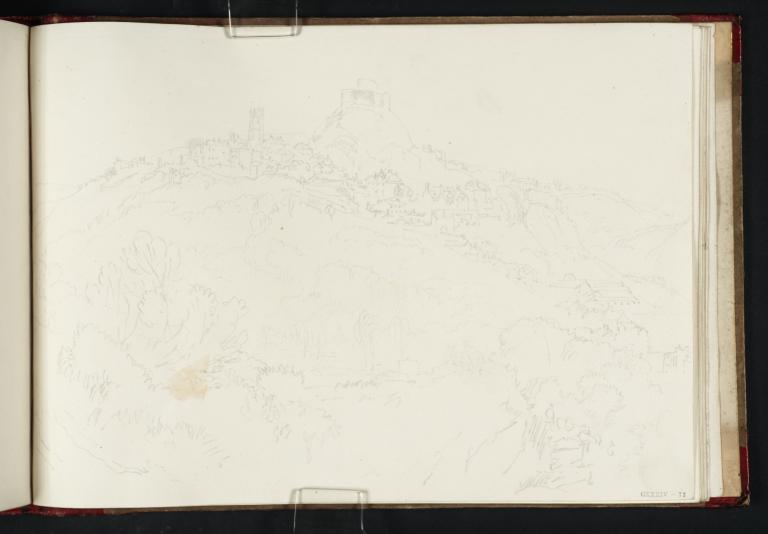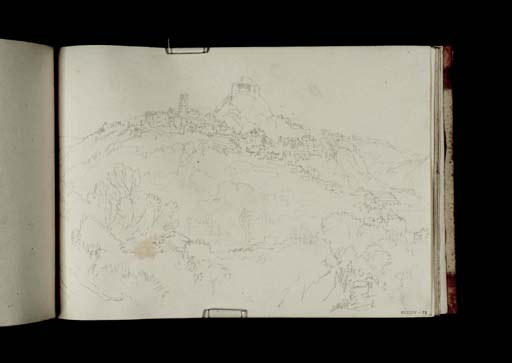Joseph Mallord William Turner Launceston from the North-West 1814
Image 1 of 2
Joseph Mallord William Turner,
Launceston from the North-West
1814
Joseph Mallord William Turner 1775–1851
Folio 70 Recto:
Launceston from the North-West 1814
D09873
Turner Bequest CXXXIV 72
Turner Bequest CXXXIV 72
Pencil on white wove paper with gilt edges, 179 x 254 mm
Inscribed by Turner ‘[?Grs]’ bottom centre
Blind-stamped with Turner Bequest monogram bottom right
Stamped in black ‘CXXXIV – 72’ bottom right
Inscribed by Turner ‘[?Grs]’ bottom centre
Blind-stamped with Turner Bequest monogram bottom right
Stamped in black ‘CXXXIV – 72’ bottom right
Accepted by the nation as part of the Turner Bequest 1856
Exhibition history
1878
Oxford Loan Collection, University Galleries, Oxford, 1878–1909 or later (62; renumbered 66a).
References
1904
E.T. Cook and Alexander Wedderburn eds., Library Edition: The Works of John Ruskin: Volume XIII: Turner: The Harbours of England; Catalogues and Notes, London 1904, p.563 (Catalogue of Sketches by Turner Lent by the Trustees of the National Gallery to the Ruskin Drawing School, Oxford. [1878]), no.66, as ‘Launceston. England drawing.’.
1909
A.J. Finberg, A Complete Inventory of the Drawings of the Turner Bequest, London 1909, vol.I, p.383, CXXXIV 72, as ‘Launceston’.
1979
Eric Shanes, Turner’s Picturesque Views in England and Wales 1825–1838, London 1979, p.156.
1979
Andrew Wilton, J.M.W. Turner: His Life and Work, Fribourg 1979, p.392 under no.792.
1999
J.R. Piggott, ‘Salerooms Report’, Turner Society News, no.82, August 1999, p.4.
Built on a large natural mound high on a hill, Launceston Castle dominates the town of the same name just inside Cornwall, west of the county border along the River Tamar. Now in the care of English Heritage, it dates from soon after the Norman Conquest and its thirteenth-century keep comprises a round tower inside an earlier circular shell.1 Here, the viewpoint is along St Stephen’s Hill, with the castle and St Mary Magdalene’s Church seen to the south-east across the valley of the River Kensey. Later buildings and trees now obscure the approach in places, but south of the junction with St Cuthbert Close, Turner’s prospect can be readily recognised.
John Ruskin recognises this sketch as relating to the watercolour Launceston, Cornwall of about 1826 (private collection),2 engraved in 1827 for the series Picturesque Views in England and Wales.3 In it, Turner introduced a lone horse and rider in the foreground, aligned with the castle and seen from the back as they approach the town. Martha Mel Edmunds has interpreted this as a depiction of George Fox, the founder of the Quakers, who was effectively persecuted on religious grounds and imprisoned in the castle for nine months in 1656.4 In a view from this direction in the contemporary Devon Rivers, No.1 sketchbook (Tate D09600; Turner Bequest CXXXII 110), a small silhouetted form may indicate a man on a horse or donkey; perhaps this observation at the scene sowed the idea of the motif in Turner’s mind.
There are other views of the castle and town on folios 69 recto, 71 recto, 72 recto, 73 recto, 74 recto, 75 recto and 76 recto (D09817, D09813, D09818–D09820, D09823, D09824; Turner Bequest CXXXIV 25, 21, 26, 27, 28, 31, 32). For nearby Polson Bridge, see under folio 77 recto (D09825; Turner Bequest CXXXIV 33), and for more Launceston sketches in the Devon Rivers, No.1 book , see under Tate D09596 (Turner Bequest CXXXII 106).
See ‘Launceston Castle’, English Heritage, accessed 28 April 2014, https://www.english-heritage.org.uk/daysout/properties/launceston-castle .
Wilton 1979, p.392 no.792, reproduced; unspecified drawings ‘made at Launceston’ in this sketchbook and elsewhere are mentioned.
Technical notes:
The page is slightly darkened overall from prolonged display; there is an unaffected strip along the top edge which was protected by the mount. There is a brown stain around an old repair to a tear in the surface towards the bottom left.
Verso:
Blank. The recto is one of eight drawings from this sketchbook lent to Oxford University in the nineteenth century (for the others see the sketchbook’s Introduction). Each has a large pencil number inscribed on the back which presumably relates to this loan, although they do not tally with the Oxford catalogue numbers.
Matthew Imms
July 2014
How to cite
Matthew Imms, ‘Launceston from the North-West 1814 by Joseph Mallord William Turner’, catalogue entry, July 2014, in David Blayney Brown (ed.), J.M.W. Turner: Sketchbooks, Drawings and Watercolours, Tate Research Publication, September 2014, https://www


